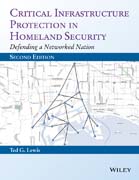
Critical Infrastructure Protection in Homeland Security: Defending a Networked Nation
Lewis, Ted G.
INDICE: 1. ORIGINS OF CIP 1.1 Recognition 1.2 Natural disaster recovery 1.3 Definitional phase 1.4 Public–private cooperation 1.5 Federalism: Whole of government 1.6 Infrastructure protection within DHS 1.7 Implementing a risk strategy 1.8 Analysis 1.9 Exercises 2. RISK STRATEGIES 2.1 Expected utility theory 2.2 PRA and fault trees 2.3 MRBA and resource allocation 2.4 PRA in the supply chain 2.5 Protection versus response 2.6 Threat is an output 2.7 Bayesian belief networks 2.8 A Bayesian network for threat 2.9 Risk of a natural disaster 2.10 Earthquakes 2.11 Black swans and risk 2.12 Black swan floods 2.13 Are natural disasters getting worse? 2.14 Black swan al Qaeda attacks 2.15 Black swan pandemic 2.16 Risk and resilience 2.17 Exercises 3. THEORIES OF CATASTROPHE 3.1 Normal accident theory 3.2 Blocks and springs 3.3 Bak’s punctuated equilibrium theory 3.4 Tragedy of the commons 3.5 The US Electric Power Grid 3.6 Paradox of enrichment 3.7 Competitive exclusion 3.8 Paradox of redundancy 3.8 Resilience of complex infrastructure systems 3.9 Emergence 3.10 Exercises 4. COMPLEX CIKR SYSTEMS 4.1 CIKR as networks 4.2 Cascading CIKR systems 4.3 Network flow resilience 4.4 Paradox of redundancy 4.5 Network risk 4.6 Exercises 5. COMMUNICATIONS 5.1 Early years 5.2 Regulatory structure 5.3 The architecture of the communications sector 5.4 Risk analysis 5.5 Cellular network threats 5.6 Analysis 5.7 Exercises 6. INTERNET 6.1 Internet as a disruptive technology 6.2 The autonomous system network 6.3 Origins of TCP/IP 6.4 Internet standards 6.5 Toward commercialization 6.6 The World Wide Web 6.7 Internet governance 6.8 Analysis 6.9 Exercises 7. CYBER THREATS 7.1 Script kiddies and black–hats 7.2 Tools of the trade 7.3 Botnets 7.4 Cyber risk analysis 7.5 Cyber Infrastructure risk 7.6 Analysis 7.7 Exercises 8. Information Technology 8.1 Principles of IT security 8.2 Enterprise systems 8.3 Cyber defense 8.4 Basics of encryption 8.5 Asymmetric encryption 8.6 RSA illustrated 8.7 PKI 8.8 Counter–measures 8.9 Exercises 9. CYBER POLICY 9.1 A National Priority and a (Familiar) Call to Arms 9.2 Rewriting Cybersecurity Policy: The Difficulty of Reform 9.3 Cybersecurity, Critical Infrastructure, and Public Policy: An Ongoing—and—Difficult Evolution 9.4 Exercises 10. SUPERVISORY CONTROL AND DATA ACQUISITION 10.1 What is SCADA? 10.2 SCADA versus enterprise computing differences 10.3 Common threats 10.4 Who is in charge? 10.5 SCADA everywhere 10.6 SCADA risk analysis 10.7 SFPUC SCADA redundancy 10.8 Analysis 10.9 Exercises 11. WATER AND WATER TREATMENT 11.1 From germs to terrorists 11.2 Foundations: SDWA of 1974 11.3 The Bio–terrorism Act of 2002 11.4 The architecture of water systems 11.5 The Hetch Hetchy network 11.6 Cascade analysis 11.7 Hetch Hetchy investment strategies 11.8 Hetch Hetchy threat analysis 11.9 Analysis 11.10 Exercises 12. ENERGY 12.1 Energy fundamentals 12.2 Regulatory structure of the energy sector 12.3 Interdependent coal 12.4 The rise of oil and the automobile 12.5 Energy supply chains 12.6 The critical Gulf of Mexico cluster 12.7 Threat analysis of the Gulf of Mexico supply chain 12.8 Network analysis of the Gulf of Mexico supply chain 12.9 The KeystoneXL pipeline controversy 12.10 The natural gas supply chain 12.11 Analysis 12.12 Exercises 13. ELECTRIC POWER 13.1 The Grid 13.2 From death rays to vertical integration 13.3 Out of orders 888 and 889 comes chaos 13.4 The North American grid 13.5 Anatomy of a blackout 13.6 Threat analysis 13.7 Risk analysis 13.8 Analysis of WECC 13.9 Analysis 13.10 Exercises 14. HEALTHCARE AND PUBLIC HEALTH 14.1 The sector plan 14.2 Roemer’s model 14.3 The complexity of public health 14.4 Risk analysis of HPH sector 14.5 Bioterrorism 14.6 Epidemiology 14.7 Predicting pandemics 14.8 Bio–surveillance 14.9 Network pandemics 14.10 The world travel network 14.11 Exercises 15. TRANSPORTATION 15.1 Transportation under transformation 15.2 The road to prosperity 15.3 Rail 15.4 Air 15.5 Airport games 15.6 Exercises 16. SUPPLY CHAINS 16.1 The world is flat, but tilted 16.2 The world trade web 16.3 Risk assessment 16.4 Analysis 16.5 Exercises 17. BANKING AND FINANCE 17.1 The financial system 17.2 Financial networks 17.3 Virtual currency 17.4 Hacking the financial network 17.5 Hot money 17.6 The end of stimulus? 17.7 Fractal markets 17.8 Exercises A. MATH: PROBABILITY PRIMER A.1 A priori probability A.2 A posteriori probability A.3 Random networks A.4 Conditional probability A.5 Bayesian Networks A.6 Bayesian reasoning A.7 Further reading B. MATH: RISK AND RESILIENCE B.1 Expected utility theory B.2 Bayesian Networks B.3 Exceedence and PML Risk B.4 Network Risk B.5 Model–Based Risk Analysis (MBRA) C. MATH: SPECTRAL RADIUS C.1 Network as matrix C.2 Matrix diagonalization C.3 Relationship to risk and resilience D. MATH: TRAGEDY OF THE COMMONS D.1 Lotka–Volterra model D.2 Hopf–Holling model E. GLOSSARY
- ISBN: 978-1-118-81763-6
- Editorial: Wiley–Blackwell
- Encuadernacion: Cartoné
- Páginas: 416
- Fecha Publicación: 14/11/2014
- Nº Volúmenes: 1
- Idioma: Inglés
- Inicio /
- /
